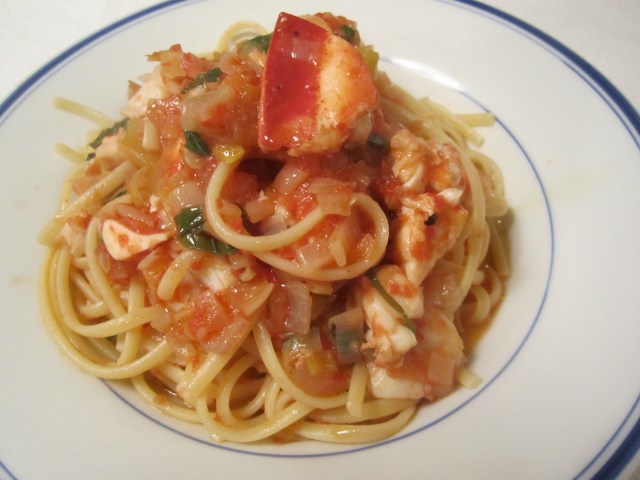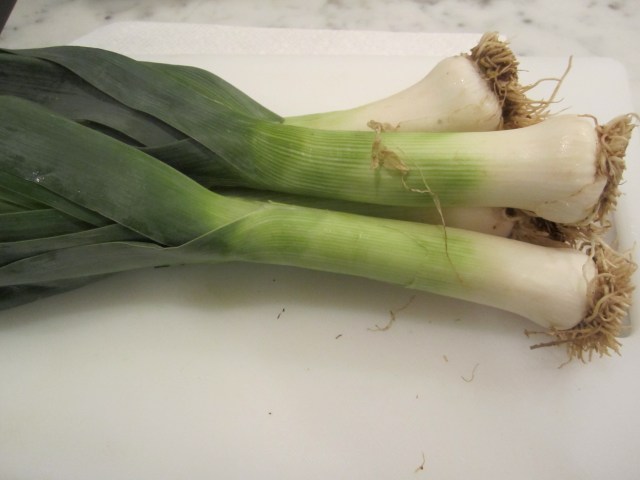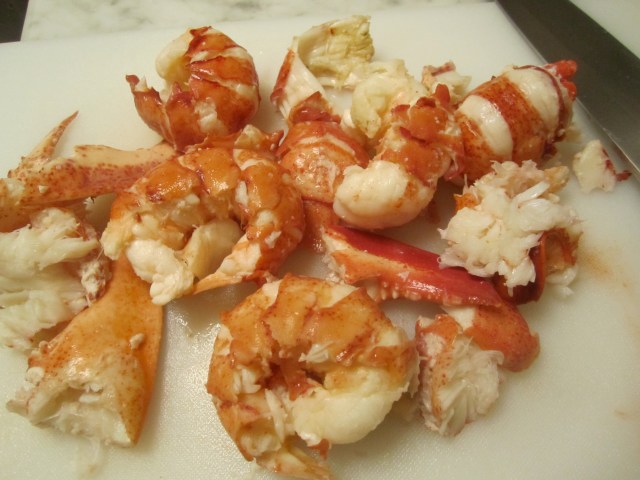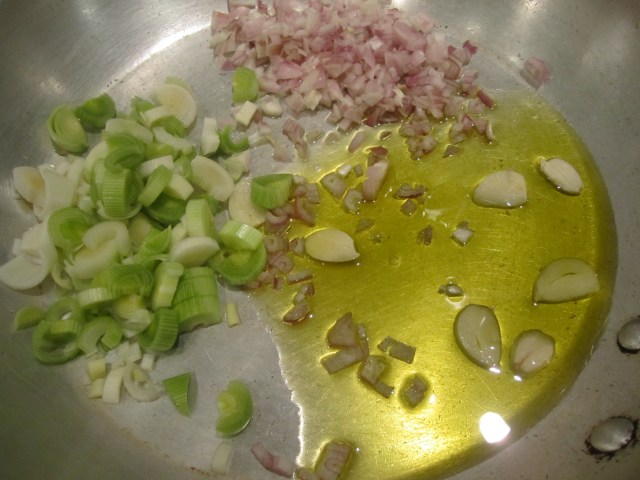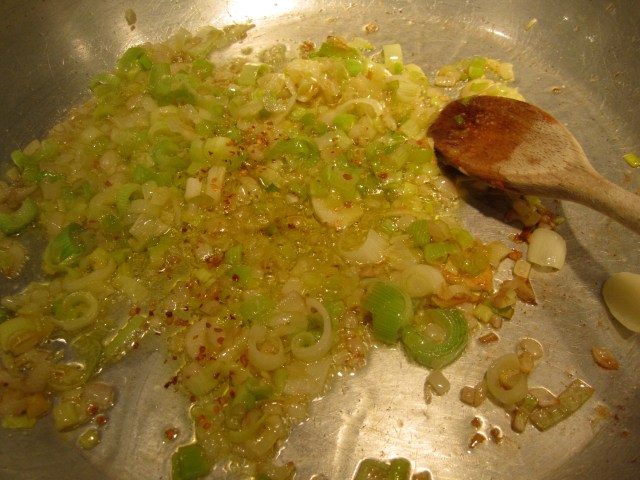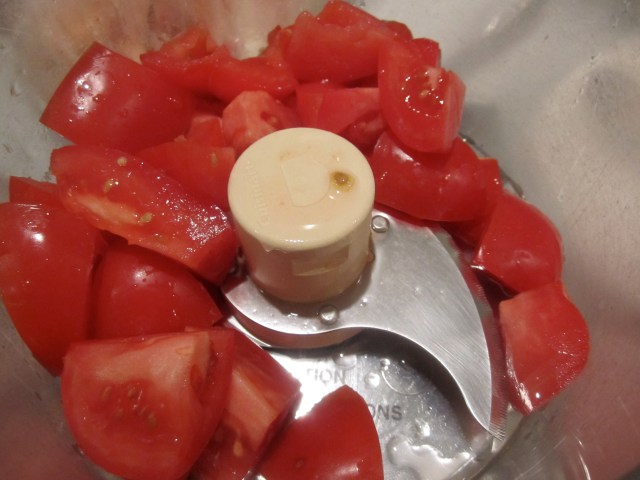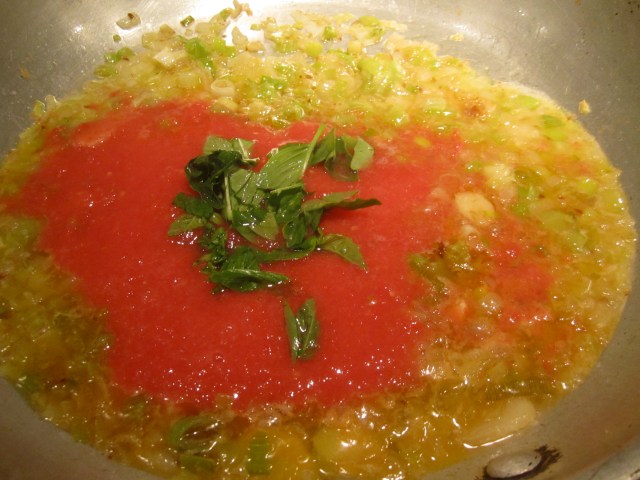

This is the perfect dish to feed a crowd. We’re expecting a houseful of twenty-somethings this weekend, so this dish will be served Friday evening, upon everyone’s arrival, and will provide us with decadent snacks all weekend long.
Lasagna is always an opportunity for me to experiment with different combinations of ingredients. Tonight, I’ve decided to make one red lasagna with meat (sweet pork sausage) and the other white, with vegetables (spinach and zucchini).
I’ve made a large batch of light tomato-basil sauce for the red lasagna, as well as a double batch of white (béchamel) sauce, which will be added to both the red and white lasagna. The béchamel sauce is the ingredient that elevates these lasagne to something magnificently smooth and decadent.
I learned about the magic of béchamel from my cousin Rosanna (who lives in Parma), when she visited and made Lasagna Bolognese for us. In Bologna, lasagna is made by layering thin sheets of homemade spinach pasta with Ragu Bolognese, béchamel, and lots of grated parmigiano reggiano. This is the gold standard of lasagna in Italy, and béchamel is the reason. It tempers the meat sauce and adds a velvety richness that is indescribable.
My other secret is no-boil pasta from Barilla. I don’t often tout specific brand names, but this pasta is an absolute necessity in the preparation of virtually foolproof lasagna.

These noodles eliminate the need for the pre-boiling of pasta sheets and provide a delicate, light-textured pasta that is almost indistinguishable from homemade (no exaggeration).
These noodles absorb great amounts of liquid in the baking process, so the one important aspect of this dish is to have lots of sauce on hand. The sauce should be much thinner and more generously applied than conventional pasta sauce, due to the highly absorbent nature of the pasta.
Therefore, for this dish, I make my red sauce very thin, which means essentially that very little simmering is required. I sauté the onions in olive oil, add the tomatoes and basil, and cook for a mere 5 minutes or so.
The béchamel is used sparingly in the red lasagna, so it can be ladled on in dollops of full-strength thickness. For the white lasagna, however, I thin the béchamel with chicken broth. The broth is essential in the white lasagna, to lighten up this otherwise very rich sauce. Also, for the white lasagna, I decided to add a cube of frozen pesto (optional), given to me by my 92 year-old neighbor, Beppi, made with the first cutting of basil from his garden.
The beautiful thing about lasagna is that it can be prepared entirely in advance, and baked while your guests are arriving and settling in. The cleanup is able to be done in advance, and all that is necessary to accompany this dish is a green salad, dressed as lightly and brightly as possible with lemon and olive oil.
I discovered that despite the fact that all of my guests were meat-eaters, the favorite, by all accounts, was the white lasagna with vegetables. But, I’d urge you to try making both lasagne and allowing your guests to decide!
White Lasagna with Vegetables

serves 12 – 16 persons generously
2 boxes of Barilla no-boil lasagna noodles (more, if necessary)
6 packages frozen chopped spinach
1 qt fresh ricotta
6 medium zucchini (approximately 8″ long)
1 large red onion, coarsely diced
2 tbls olive oil
approximately 2 qts béchamel sauce (recipe below)
1 1/2 c chicken broth
1/4 c basil pesto sauce (optional) (see Pasta with Shrimp and Pesto for recipe)
1 lb freshly grated parmigiano reggiano
1/4 tsp nutmeg
salt and pepper to taste
Preheat oven to 375 degrees.
Thaw and squeeze the spinach as tightly as possible in small handfuls. Set aside.

Slice zucchini and place in a large skillet with onion and olive oil. Saute on high heat for about 15 minutes, or until beginning to turn golden and soft.

Season generously with salt and pepper. Set aside.
Combine spinach, ricotta, and nutmeg in a bowl. Mix well, add salt and pepper to taste and set aside.
Combine béchamel, pesto and chicken broth. The resulting sauce should have the consistency of a light cream soup.
In a large baking pan (I used a ‘restaurant pan’, which measures approximately 12″ x 20″ x 2.5″ deep) spread a generous layer of béchamel on the bottom.

Begin by adding a layer of pasta sheets, arranging to cover the bottom, without overlapping. If there are any large holes, simply break a sheet of pasta to fit the gap. There can be a bit of space around the noodles.
Add a dollops of spinach and ricotta, and a loose layer of zucchini/onion mixture. Sprinkle with plenty of grated parmigiano, and ladle on plenty of thinned-out béchamel.

Repeat with 3 additional layers of pasta, for a total of 4 layers, pressing down on each layer of pasta before adding the next. Finish the top layer with pasta sheets topped with only béchamel and grated cheese.

Cover and bake for one hour at 375 degrees. Uncover and bake for 10 minutes to form a slightly golden crust on top.
Let rest for approximately 15 minutes prior to carving.
Red Lasagna with Pork Sausage

serves 12 – 16 persons generously
2 packages of Barilla no-boil lasagna sheets (more, if necessary)
3 quarts light tomato-basil sauce (recipe below)
2 lbs pork sausage
2 tbls olive oil
1 qt béchamel sauce
1 qt fresh ricotta
1 lb grated parmigiano reggiano
salt and pepper to taste
Preheat oven to 375 degrees.
Remove sausage from its casing and saute in olive oil on medium heat, breaking up the chunks with a metal spoon.

Continue sauteing and breaking up with the metal spoon or spatula until it becomes golden and slightly crisp around the edges. Set aside.

In a large baking pan (approximately 12″ x 20″ x 2.5″deep), spread a layer of tomato-basil sauce. Add a layer of pasta sheets, not overlapping. Spread sausage evenly in one layer. Add tablespoon-size dollops of ricotta, then sprinkle generously with grated cheese. Top generously with dollops of béchamel and tomato sauce.

Hold back on the béchamel, but be generous with the tomato sauce. The tomato sauce is the liquid medium in which the pasta will cook–the béchamel is just to add a rich texture and creamy undertone.
Repeat with 3 additional layers of pasta, topping with tomato sauce, béchamel and lots of grated cheese.
Bake, covered tightly with foil, for approximately one hour. No need to brown the top of this lasagna. Remove from oven and set aside for 15 minutes to settle before carving.
Béchamel Sauce
enough for 2 lasagne
3 sticks (24 tbls) unsalted butter
3/4 c flour
3 1/2 qts whole milk
1/2 tsp freshly grated nutmeg
salt and pepper to taste (be generous with salt)
In a heavy saucepan on medium heat, place butter and flour.

Whisk over medium heat for about 5 minutes, or until flour and butter are thoroughly combined. Do not brown.
Turn flame to high and add milk. Bring to a simmer and reduce heat to low. Add nutmeg, salt and pepper.

Whisk and stir until thickened. Should be a thick consistency. Set aside to partially cool.
Light Tomato-Basil Sauce
4 28-oz. cans whole peeled tomatoes, pureed lightly in blender
1 large red onion, peeled and diced finely.
1/2 c extra virgin olive oil
2 large stalks basil
salt and pepper to taste.
In a heavy saucepan, combine onions and olive oil.

Saute on low heat for approximately 10 minutes, or until onions have wilted but not browned. Add tomatoes, basil, and a generous amount of salt and pepper.

Bring to a boil, and lower heat. Simmer for 5 minutes. Add salt and pepper to taste. Remove basil stalks. Set aside to partially cool.
 Serve with plenty of grated parmigiano at the table.
Serve with plenty of grated parmigiano at the table.





























































